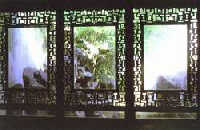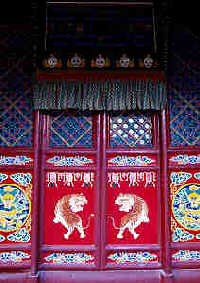 It is a grand feast for the eyes when lingering on the lines of China's antique doors and windows, which are legacies from the Ming (1368-1644) and Qing (1644-1911) dynasties, and when appreciating the excellent workmanship, wood, and styling. The doors and windows, elaborately carved with latticework (a kind of openwork in which strips of wood or metal are fastened together in a cross, thereby forming square- or diamond-shaped spaces in between) and bas-reliefs (carvings that rise from the background), have become the hallmarks of classic antique Chinese architectural ornamentation as well as furniture.
It is a grand feast for the eyes when lingering on the lines of China's antique doors and windows, which are legacies from the Ming (1368-1644) and Qing (1644-1911) dynasties, and when appreciating the excellent workmanship, wood, and styling. The doors and windows, elaborately carved with latticework (a kind of openwork in which strips of wood or metal are fastened together in a cross, thereby forming square- or diamond-shaped spaces in between) and bas-reliefs (carvings that rise from the background), have become the hallmarks of classic antique Chinese architectural ornamentation as well as furniture.
 Fanciful latticework
Fanciful latticework
The latticework of diverse and elaborate designs that characterizes the traditional doors and windows has exerted a far-reaching influence on Chinese architectural ornamentation. In ancient times, one's house usually told much about his or her taste, status, and wealth. As a result, when a person had a house built for him or her, he or she paid much attention to its architecture.
result, when a person had a house built for him or her, he or she paid much attention to its architecture.
In some window latticework you may still find thin layers of gold foil, which indicates the houses' past eminence, while some carved boards feature geometric variations of Buddhist symbols. Others are carved with poems and lyrics, or even calligraphy and paintings, which implies that literary families once lived in the houses.
Traditional Chinese doors and windows display a wide range of latticework motifs that are a reflection of the Chinese philosophy on the harmony between man and nature.
Latticework motifs on doors, partitions, and windows are mostly derived from traditional designs with auspicious meanings, such as storks, deer, kylins (Chinese mythical beasts), pied magpies, bats, peonies, and fu (the Chinese character for happiness), all symbolizing longevity, good health, and wealth.
